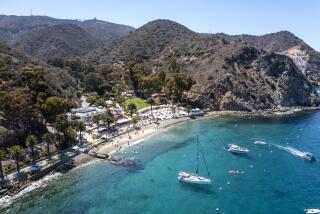Martinique Sparkles as French Caribbean Jewel
- Share via
FORT-DE-FRANCE, Martinique — A morning with Gauguin, an afternoon with the Empress Josephine, shopping at the Parisian showcase along Rue Victor Hugo, dining at La Grande Voile. It feels good to be in France again . . though Paris is more than 4,300 miles away.
To get to know Martinique is to realize that the island is much more than a French territory bounded on the west by the tranquil beaches and coral reefs of the Caribbean Sea and on the east by the surfing waters of the Atlantic Ocean.
Martinique is a full-fledged departement of France, identical in political structure to the country’s other departements --a status comparable in many ways to the states of the United States.
The currency is the French franc, and the basic language is so much the mother tongue of France that it’s always helpful to brush up on your high school or college French before you arrive here by cruise ship or air.
But France and the French language are only the base of the cultural heritage and rich diversity to be enjoyed here.
A Touch of Tahiti
Martinique is also a Tahiti in the Caribbean, a Tahiti enriched with a Creole patois that borrows from Spanish, English, French and African languages.
The sugar-cane fields, the pineapple, papaya, mango, royal palm, giant bamboo and other trees and groves of Hawaii are here too, along with beaches of black sand and white sand.
Martinique also has Mont Pelee, a volcanic mountain that erupted early in this century and an unforgettable experiences for today’s visitor.
To the Carib Indians, Martinique was the “island of flowers,” and so it remains today. The many hues of hibiscus, anthurium, poinsettia, oleander and bougainvillea bring the tones of a Gauguin painting to the valleys and hillsides, the villages and residential streets in the capital city of Fort-de-France.
Columbus landed on Martinique in 1495. Since 1695, except for three short periods of occupation by the British, the island has been unmistakably French.
Paris of the Island
Fort-de-France, with a population of about 100,000, is the Paris of the island. The people live without a sense of being crowded on a land area about 50 miles long and up to 20 miles wide.
The capital city rises like an amphitheater into the green hills around its bay and harbor. Rue Victor Hugo is one of four shopping streets featuring some of the most select designer labels, perfumes, jewelry, silver tableware, porcelain and crystal of France. Galerie d’Art Pierre displays noted French and Caribbean artists. Some brand-name perfumes can be purchased at less than 50% U.S. prices.
St. Louis Cathedral, built in Romanesque style during the late 19th Century, is famed for its grand organ. The Sacre Coeur de Martinique Cathedral will remind you of the Sacre Coeur in Paris.
The Departmental Museum contains cultural and artistic treasures dating back to the Arawak Indians, original inhabitants of Martinique and much of the Caribbean world. The museum faces the central city Parc La Savane, a dozen acres of magnificent tropical plants and trees.
The historic community of Trois Ilets is a short drive or a 20-minute ferryboat ride across the bay from Fort-de-France. The Pagerie Museum there is in flower gardens amid the ruins of old plantation buildings on the estate where Empress Josephine once lived. Its exhibits include love letters exchanged by Josephine and Napoleon, and the bed in which she slept as a child.
Seashell Tales
At the Shell Museum near Trois Ilets, figures and tableaux made of seashells tell the story of local life and historical events.
The white-sand beaches around Trois Ilets frame many of the top resort hotels of Martinique. Both the Bakoua Beach and Meridien resorts are rated four-star properties.
The Bakoua Beach has 100 luxury rooms overlooking the beach and sailboats at mooring. Two restaurants offer French and Creole cuisine. Orchestras invite dancing to the music of Paris and the Caribbean. The resort has tennis, fishing, sailing, diving and water-skiing facilities and equipment. Golf is at the nearby Empress Josephine Golf Course, an 18-hole championship course designed by Robert Trent Jones.
South and eastward from Trois Ilets to the southernmost tip of the island are some of the loveliest beaches in the Caribbean. Charming fishing villages make the coast a haven for sailboats. The village of La Diamant looks out upon the rugged grandeur of Diamond Rock.
Throughout this southern region, as in Fort-de-France and on most of the island, accommodations for visitors range from the grand resorts to the small relais and auberges so characteristic of the French countryside.
Range of Prices
With major cruise lines planning expeditions that will as much as double passenger capacity in the Caribbean during the coming decade, Martinique is keeping pace with other islands by showcasing accommodations in a wide spectrum of prices for cruise visitors who will be tempted to return for longer stays.
Doubles at the four-star Bakoua Beach resort start at $99 with continental breakfast through mid-December, then $205 during the peak winter season. Doubles at the Diamant Les Bains, a cozy family-style relais right on the sea facing Diamond Rock, are $44 with continental breakfast and will go to $68 after mid-December.
Driving north from Fort-de-France along the Caribbean coast, the village of Le Carbet discloses a year in the life of French Impressionist artist Gauguin. He spent 1887 there, four years before leaving France for Tahiti. The Gauguin Museum of Carbet displays results of his Caribbean period and documents and letters show his fascination with the colors of the sea and mountains.
Just beyond Le Carbet, the winding coastal road leads to the town of Saint Pierre. The town was built as a military base in 1635, across the harbor from 4,656-foot Mont Pelee. The city grew to be the largest on the island, a center of culture around its theater.
Lone Survivor
Some 29,000 people were living here on the eve of May 8, 1902. That was the day Mont Pelee erupted, generating heat of 1,000 degrees centigrade and sending ashes around the earth. Only one person in the city survived the eruption. He was Ciparis, who had been in prison for a month because of a drunken brawl. His cell was in an arch of thick stone walls next to the theater. The miracle of his survival made him a Barnum & Bailey circus attraction in the United States.
Mont Pelee has been dormant since 1932, a sleeping serenity of verdant green slopes often crowned with a drifting white cloud. Saint Pierre is now a town of about 6,000. A museum shows what happened on that tragic day in 1902, conserving many of the artifacts that were calcified in the inferno. A dedicated association is protecting the ruins, which were visited by classes of island schoolchildren while we were there.
The road turning into the mountains above Saint Pierre leads to banana plantations and then into a tropical forest that could be on an island in the South Pacific.
For information on Martinique, contact the French Government Tourist Office, 9401 Wilshire Boulevard, Suite 840, Beverly Hills 90212, phone (213) 272-2661.
More to Read
Sign up for The Wild
We’ll help you find the best places to hike, bike and run, as well as the perfect silent spots for meditation and yoga.
You may occasionally receive promotional content from the Los Angeles Times.






